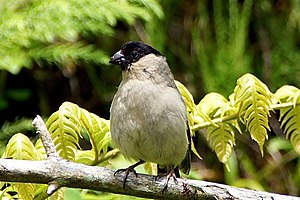Azores bullfinches
| Azores bullfinches | ||||||||||||
|---|---|---|---|---|---|---|---|---|---|---|---|---|

Azores bullfinch ( Pyrrhula murina ) |
||||||||||||
| Systematics | ||||||||||||
|
||||||||||||
| Scientific name | ||||||||||||
| Pyrrhula murina | ||||||||||||
| Godman , 1866 |
The Azores Bullfinch ( Pyrrhula murina ), and São Miguel Bullfinch or Priolo called, is a bird art from the family of finches (Fringillidae).
features
The Azores bullfinch reaches a height of 17 centimeters. It is a plump bird with short wings and a long tail. The crown of the head, face mask, conical beak, tail and wings are black. The back is brown. The nape of the neck and the upper tail covers are gray. The underside is pink-brown. The sexes can hardly be distinguished, but in the males the underside shows a more pale pink tint.
distribution and habitat
The range of the Azores bullfinch is limited to less than 60 km² at Pico da Vara in the east of the Azores island of São Miguel .
Way of life
The Azores bullfinch feeds on semi-ripe and ripe seeds of wild herbs .
Existence and endangerment
BirdLife International estimates the population at 1300 individuals and classifies the species in the “endangered” category. It was still common in the 19th century, but since it invaded the farmers' orchards, it was persecuted as a pest. In 1927 it was initially considered to be extinct, but in 1968 some specimens were rediscovered on the slopes of Pico da Vara . Today the greatest threat comes from habitat loss and neophytes .
Systematics
The Azores bullfinch was at times considered a subspecies of the bullfinch ( Pyrrhula pyrrhula ). However , according to phylogenetic studies, it differs fundamentally from the British and Northern European specimens of bullfinches in terms of mitochondrial DNA . Therefore, the Azores bullfinch received species status in 1993.
literature
- G. Aubrecht: The Azores bullfinch - pursued, lost, rediscovered . Feathered World 2/97: 76, 1997
- David A. Bannerman , WM Bannerman: Birds of the Atlantic islands. Volume 3: A history of the birds of the Azores. Oliver and Boyd, Edinburgh 1966.
- CJ Bibby, TD Charlton: Observations on the Sao Miguel Bullfinch . Açoreana 7: 297-304, 1991
- CJ Bibby, TD Charlton, JA Ramos: Studies of West Palearctic birds, the Azores Bullfinch . Brit. Birds 85: 677-680, 1992
- Gerard Le Grand: The rediscovered Azores bullfinch . We and Vogel 15 (1): 37-38, 1983
- JA Ramos: Introduction of Exotic Tree Species as a Threat to the Azores Bullfinch Population ( abstract, online )
- JA Ramos: Status and ecology of the Priolo or Azores Bullfinch . Ph.D. Thesis, University of Oxford, 1993
- JA Ramos: The annual cycle of the Azores Bullfinch . Arquipelago. Ser. Cien. Nat. 12A: 101-109, 1994
- JA Ramos: Fern frond feeding by the Azores Bullfinch . J. Avian Biol. 25: 344-347, 1994 ( abstract, online )
- JA Ramos: The diet of the Azores Bullfinch Pyrrhula murina and floristic variation within its range . Biol. Conserv. 71: 237-249, 1995
- JA Ramos: Action plan for the Azores Bullfinch (Pyrrhula murina) . P. 347-352 in B. Heredia, L. Rose and M. Painter, eds: Globally threatened birds in Europe: action plans . Strasbourg: Council of Europe and BirdLife International, 1996
- JA Ramos: Azores Bullfinch Pyrrhula murina . Bull. African Bird Club 7: 31-33, 2000
- F. Vester, AW Diamond, H. Stern, RL Schreiber: Save the bird world . ProNatur publishing house, 1989
Web links
- BirdLife Species factsheet
- Website about the Azores bullfinch ( Memento of June 10, 2007 in the Internet Archive )
- Action plan for the Azores bullfinch (PDF file; 52 kB)
- Page about the Azores bullfinch
- ARKive - Pictures and details of Pyrrhula murina
- Birdwatch - Protecting the Priolo (PDF file; 2.56 MB)
- Pyrrhula murina in the endangered Red List species the IUCN 2008. Posted by: BirdLife International, 2008. Accessed on December 20 of 2008.